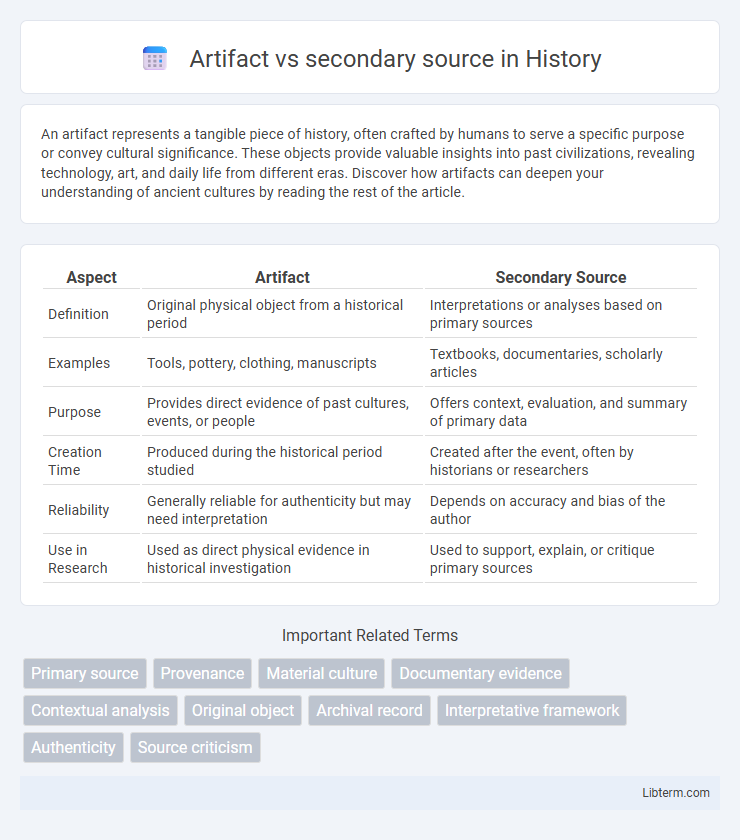An artifact represents a tangible piece of history, often crafted by humans to serve a specific purpose or convey cultural significance. These objects provide valuable insights into past civilizations, revealing technology, art, and daily life from different eras. Discover how artifacts can deepen your understanding of ancient cultures by reading the rest of the article.
Table of Comparison
| Aspect | Artifact | Secondary Source |
|---|---|---|
| Definition | Original physical object from a historical period | Interpretations or analyses based on primary sources |
| Examples | Tools, pottery, clothing, manuscripts | Textbooks, documentaries, scholarly articles |
| Purpose | Provides direct evidence of past cultures, events, or people | Offers context, evaluation, and summary of primary data |
| Creation Time | Produced during the historical period studied | Created after the event, often by historians or researchers |
| Reliability | Generally reliable for authenticity but may need interpretation | Depends on accuracy and bias of the author |
| Use in Research | Used as direct physical evidence in historical investigation | Used to support, explain, or critique primary sources |
Introduction to Artifacts and Secondary Sources
Artifacts represent original objects created or used by people in historical or cultural contexts, providing direct evidence of past events, practices, or societies. Secondary sources interpret, analyze, or summarize information from primary materials like artifacts, often offering context or scholarly perspectives. Understanding the distinction between artifacts and secondary sources is essential for accurate historical research and analysis.
Defining Artifacts: Meaning and Examples
Artifacts are tangible objects created or used by humans that provide direct evidence about past cultures, such as tools, pottery, and clothing. Unlike secondary sources, which interpret or analyze historical events through documents or media, artifacts offer primary, physical insight into daily life, technology, and social practices. Examples include ancient manuscripts, archaeological findings like arrowheads, and preserved garments from historical periods.
Understanding Secondary Sources
Secondary sources interpret, analyze, or summarize information originally presented in primary sources or artifacts, offering context and critical evaluation. Understanding secondary sources involves recognizing their role in providing scholarly perspectives and synthesizing multiple primary materials to present comprehensive insights. Effective use of secondary sources enhances research accuracy by situating artifacts within broader historical, cultural, or scientific frameworks.
Key Differences Between Artifacts and Secondary Sources
Artifacts are physical objects created during a specific historical period that provide direct evidence about the culture, technology, or daily life of that time, while secondary sources interpret, analyze, or summarize information from primary materials such as artifacts or documents. Artifacts offer firsthand, tangible connection to the past, often requiring archaeological methods for examination, whereas secondary sources rely on authors' research and perspective, shaping the understanding of historical events or artifacts. The key difference lies in artifacts being original, tangible evidence, whereas secondary sources are derivative interpretations or explanations based on primary data.
Role of Artifacts in Historical Research
Artifacts serve as tangible primary sources that provide direct evidence of past cultures, events, and daily life, enabling historians to reconstruct historical contexts with accuracy. Unlike secondary sources that interpret or analyze information, artifacts offer unmediated insights through physical characteristics, material composition, and usage marks. Their role in historical research is essential for verifying accounts, filling gaps in written records, and offering multidimensional perspectives on ancient societies.
Importance of Secondary Sources in Analysis
Secondary sources are crucial in historical analysis as they provide interpretation, context, and synthesis of information derived from primary artifacts and documents. They help researchers understand broader connections, validate the significance of artifacts, and offer diverse perspectives that enrich the comprehension of historical events. Relying on credible secondary sources ensures a well-rounded analysis by integrating expert insights and scholarly consensus.
Advantages of Using Artifacts
Artifacts provide direct, tangible evidence from a particular time or culture, offering authentic insights that secondary sources may interpret or summarize. They allow researchers to analyze material culture firsthand, leading to more accurate and nuanced understanding of historical contexts. Using artifacts can reveal information unavailable in written records, such as technological advances, artistic styles, and everyday life details.
Limitations of Secondary Sources
Secondary sources often rely on the interpretation and analysis of primary data, which can introduce bias or distort original meanings. The accuracy of secondary sources is limited by the quality and completeness of the primary sources they reference. Secondary sources may omit crucial context or details found only in artifacts, reducing their reliability for in-depth historical research.
How to Evaluate Authenticity and Reliability
Evaluate the authenticity of an artifact by examining its provenance, material composition, and craftsmanship, ensuring it corresponds with the historical period it claims to represent. For secondary sources, assess reliability by verifying the author's credentials, cross-referencing citations, and analyzing the consistency with primary data or other scholarly works. Authentic artifacts provide direct, tangible evidence, while reliable secondary sources offer contextual analysis and interpretation grounded in verified facts.
Choosing the Right Source for Academic Research
Artifacts provide direct, tangible evidence from historical events, making them invaluable primary sources for academic research that requires firsthand data. Secondary sources, such as scholarly articles and reviews, offer analysis, interpretation, and synthesis of primary data, supporting broader context and theoretical framing. Choosing the right source depends on the research goal: use artifacts for original, empirical evidence and secondary sources for critical insights and comprehensive understanding.
Artifact Infographic

 libterm.com
libterm.com